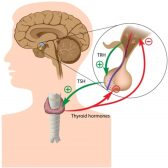Table of Contents
A dinoflagellate is a flagellate algae characterized by their two flagella of unequal length. One of the flagella is lying in the groove around the body and the other is extending from the center. It also has an armor-like shell or pellicle, a dinokaryon, and dinoflagellate toxin. Many of them are photosynthetic. The pigments present are chlorophyll a and c, carotenoids, and xanthophylls. The carbohydrate reserve is in starch, α 1-4, branched glucose polymer. Those that are unpigmented are heterotrophs, preying on other protozoa. Others are mixotrophs, capable of both photosynthesis and predation. Dinoflagellates belong to the phylum Dinoflagellata of the Superphylum Alveolata. They are found in marine and freshwater. Most of the identified species are marine (about 1500-1700). About 220 have been described as freshwater species.(1, 2) The breadth of their population depends on the availability of nutrients, salinity, and sea surface temperature.
Etymology
The term dinoflagellate came from the Ancient Greek dînos (“whirling”) and flagellate, meaning “whip”. Variant: dinoflagellate. Synonyms: Cilioflagellata (Claparède & Lachmann, 1868); Dinophyta (Dillon, 1963); Dinophyceae sensu (Pascher, 1914); Pyrrophyta (Pascher 1914); Pyrrhophycophyta (Papenfuss 1946); Arthrodelen Flagellaten (Stein 1883); Dinomastigota (Margulis & Sagan, 1985); Dinophyta (Dillon, 1963).
Classification
In five kingdom scheme of classification, the algae, together with the protozoa, belong to Kingdom Protista. They are distinct from the protozoa by being photosynthetic. The algae are further grouped into various groups: Euglenophyta, Chrysophyta (diatoms), Dinoflagellata (dinoflagellates), Chlorophyta, Charophyta, Phaeophyceae, and Rhodophyta. The Cyanophyta or blue-green algae, which are prokaryotic organisms, are traditionally included in this group but in modern classification, they are now grouped together with bacteria under Kingdom Monera. It should be noted, however, that the taxonomic classification of organisms is bound to change as further studies of the species would lead to newer system of classification, such as that in The NCBI taxonomy database.(3)
Sub-groups
The different classes belonging to phylum Dinoflagellata are as follows:
- Dinophyceae
- Duboscquellea
- Ellobiophyceae
- Noctiluciphyceae
- Oxyrrhea
- Pronoctilucea
- Psammosea
- Syndiniophyceae
General characteristics

Flagella
Dinoflagellates are unicellular organisms characterized by having two flagella: the transverse flagellum and the longitudinal flagellum. The transverse flagellum is flat, wavy, and ribbonlike that spans the transverse surface groove called cingulum. It has an axoneme that runs along it. This flagellum is responsible for the forward movement as well as in the turning and maneuvering of the dinoflagellate. The longitudinal flagellum has fewer to no hair. It lies in the surface groove, sulcus. This flagellum is responsible for the whipping motion and propelling the dinoflagellate in the direction opposite to it. The combined movements of the two flagella, whirling and whip are the basis from where the group got their name.(4)
Amphiesma
Dinoflagellates are also characterized by a cell covering called amphiesma. This cell covering is comprised of flattened vesicles called alveolae. Some flagellates have a theca (or lorica) that serves as an exterior armor.
Dinokaryon
Their nucleus is also a distinctive feature. Referred to as dinokaryon, their nucleus is characterized by the chromosomes that are fibrillar in appearance , attached to the nuclear envelope, and remain condensed even during the interphase. Their chromosomes lack centromeres and may have little or no protein. Instead of histones, dinoflagellates have a different family of nucleoproteins bound to DNA. The nucleoproteins are presumed to be of viral origin. Thus, they are referred to as dinoflagellate/viral nucleoproteins (DVNPs). During mitosis, the nuclear envelope persists. Instead of disintegrating as it does in most eukaryotes, it remains intact. The spindle has to find its way through the nucleus to coordinate the segregation of chromosomes. Dinoflagellates are mesokaryotic to indicate that their nuclear features seem to transition from those of prokaryotes to those of eukaryotes.
Large genome
Dinoflagellates have a large genome with an approximate DNA content from 3 to 250 pg/cell as opposed to the 0.54 pg DNA/cell of other algae. (4)
Pigments
Dinoflagellates that are photosynthetic have chlorophyll a and c2, xanthophylls, and carotenoids. The chlorophyll pigments are located inside a triple-membraned chloroplast (as opposed to plants’ double-membraned chloroplast). The chloroplast of the dinoflagellates may have its own nucleus.(5) The xanthophylls are typically peridinin, dinoxanthin, and diadinoxanthin. These pigments give certain dinoflagellates their golden brown color.
Eyespot and ocellus
Dinoflagellates have a light-sensitive organelle called eyespot. It contains lipid droplets inside the stacked layers of membranes where the carotenoids are laid. Thus, this organelle is able to detect the direction of the light source. Certain dinoflagellates have a rather more-advanced rare structure called the ocellus that makes use of a refracting lens that can focus an image on the retinoid lining membrane. (5)
Food reserve and other cytoplasmic structures
Food reserve is stored in form of starch like carbohydrates and oils. A noncontractile vacuole called pustule is present near the flagellar base. It may have one or more vesicles. Pustule may take part in floatation and osmoregulation. Contractile vacuoles are absent.
Life cycle
Most dinoflagellates have a haplontic type of life cycle. This means that the zygote (2n) formed from karyogamy immediately divides meiotically, producing haploid (n) cells. The haploid cells, then, divide mitotically to generate more haploid cells. The haploid cells from mitosis are called haplonts. In haplontic dinoflagellates, the asexual reproduction may be by desmoschisis or by eleuteroschisis. In desmoschisis, the parent cell divides into two daughter cells, each retaining the half of the theca of the parent. In eleuteroschisis, the parent cell first sheds its theca (by ecdysis), and then divides into two daughter cells. In sexually-reproducing dinoflagellates, the zygote may undergo a resting stage and become a hypnozygote. In dinoflagellates, the hypnozygote is called a dinocyst. Inside the cyst, the hatchling goes through meiosis to produce haploid cells.
Evolution
The triple-membraned chloroplasts of the dinoflagellates seem to indicate that another form of endosymbiotic event where they might have ingested a photosynthetic eukaryote. Another indication of possible endosymbiotic events is the presence of other algal pigments like fucoxanthin in the dinoflagellates Karenia spp. (6)
Ecology

Dinoflagellates flourish in aquatic habitats. They form endosymbiotic association with other organisms, e.g. the dinoflagellate Symbiodinium with reef-building corals. Dinoflagellates may have diverse nutritional modes. Some of them are phototrophic whereas others are heterotrophic. Others still are a mix of the two modes, and hence are referred to as mixotrophic. Those that feed on other organisms ingest foodstuff through the sulcus. They could feed on other dinoflagellates, algae, bacteria, etc.
Many of them are associated with algal blooms. Red tide phenomenon is an example of an algal bloom. It particularly occurs in marine waters. That is when certain dinoflagellate species grow at a rate faster than normal. A toxin referred to as dinoflagellate toxin is a potent neurotoxin that impairs the synthesis or the release of acetylcholine. Gymnodinium and Gonyaulax, that causes red tide, produce toxins that if accumulated by filter-feeding molluscs can be fatal when consumed. Another common genus is Peridinium.
Not all blooms though are dangerous. Bioluminescent dinoflagellates in algal blooms crate blue sparkling flash of light in ocean water. About 18 genera of dinoflagellates are capable of bioluminescence. These species have scintillons – cytoplasmic structures containing luciferase (the enzyme) and luciferin (chlorophyll-derived tetrapyrrole ring). They use bioluminescence as a defense strategy against predators.
Related terms
- Dinoflagellate toxin
See also
References
- Gómez, F (2005). “A list of free-living dinoflagellate species in the world’s oceans”. Acta Botanica Croatica. 64 (1): 129–212.
- Taylor, F. R., Hoppenrath, M., & Saldarriaga, J. F. (February 2008). “Dinoflagellate diversity and distribution”. Biodivers. Conserv. 17 (2): 407–418.
- The NCBI taxonomy database. Retrieved from http://www.ncbi.nlm.nih.gov/taxonomy.
- Spector, D. (2012-12-02). Dinoflagellate nuclei. pp. 107–147. Retrieved from https://books.google.com/books?id=qCcgFximE8oC&pg=PA107
- Morphology of the Dinoflagellata. (2019). Retrieved from Berkeley.edu website: https://ucmp.berkeley.edu/protista/dinoflagmm.html
- Hackett, J. D., Anderson, DM, Erdner DL, Bhattacharya D (October 2004). “Dinoflagellates: a remarkable evolutionary experiment”. American Journal of Botany. 91 (10): 1523–34.
© Biology Online. Content provided and moderated by Biology Online Editors







